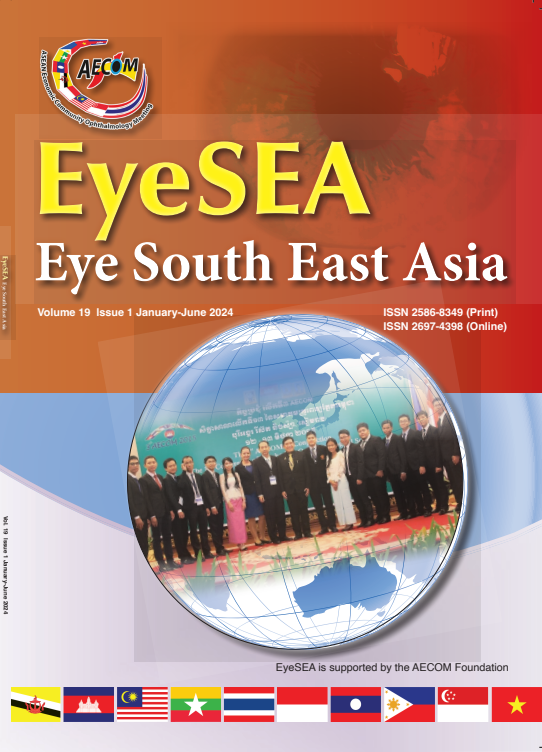Evaluation of the Relationship between Serum TSH Receptor Antibody and Dry Eye Syndrome in Graves’ Disease: A Cross-sectional Study
Main Article Content
Abstract
Background: This study aimed to evaluate the relationship between serum TSH receptor antibody levels and dry eye syndrome in Graves' disease patients without graves’ orbitopathy.
Materials and Methods: This cross-sectional study encompassed 28 eyes of 14 individuals diagnosed with Graves’ disease. Serum TSH receptor antibodies were measured followed by dry eye parameters assessed via the OCULUS Keratograph® 5M specifically Non-Invasive Keratograph Break-Up Time, tear meniscus height, and redness score. Dry eye symptoms were assessed with OSDI score.
Results: The majority of Graves’ disease patients exhibit moderate severity of dry eye symptoms (Mean OSDI score = 25.05) and high TSH receptor antibody level (Mean TRAb level = 9.61). The TSH receptor antibody level shows a significant association primarily with the redness score (r = 0.410, p = 0.030). However, no significant correlations were observed between the TSH receptor antibody level and tear meniscus height, NIKBUT, or OSDI score.
Conclusion: In Graves’ disease patients without Graves orbitopathy, a correlation was observed between Serum TSH receptor antibody levels and the redness score. However, there was no correlation between TSH receptor antibody levels and other dry eye parameters or symptoms associated with dry eye syndrome.
Conflicts of Interest: no financial interest in any products or instruments mentioned in this study.
Article Details

This work is licensed under a Creative Commons Attribution-NonCommercial-NoDerivatives 4.0 International License.
References
Weetman AP. Graves' disease. N Engl J Med. 2000; 343:1236-48.
Bahn RS. Graves' ophthalmopathy. N Engl J Med. 2010; 362:726-38.
Kahaly GJ, Wüster C, Olivo PD, Diana T. High Titers of Thyrotropin Receptor Antibodies Are Associated With Orbitopathy in Patients With Graves Disease. J Clin Endocrinol Metab. 2019; 104:2561-8.
Jang SY, Shin DY, Lee EJ, Choi YJ, Lee SY, Yoon JS. Correlation between TSH receptor antibody assays and clinical manifestations of Graves' orbitopathy. Yonsei Med J. 2013; 54:1033-9.
Eckstein AK, Finkenrath A, Heiligenhaus A, Renzing-Köhler K, Esser J, Krüger C, et al. Dry eye syndrome in thyroid-associated ophthalmopathy: lacrimal expression of TSH receptor suggests involvement of TSHR-specific autoantibodies. Acta Ophthalmol Scand. 2004; 82:291-7.
Gürdal C, Saraç O, Genç I, Kırımlıoglu H, Takmaz T, Can I. Ocular surface and dry eye in Graves' disease. Curr Eye Res. 2011; 36:8-13.
McKee A, Peyerl F. TSI assay utilization: impact on costs of Graves' hyperthyroidism diagnosis. Am J Manag Care. 2012; 18:e1-14.
Tozzoli R, Bagnasco M, Giavarina D, Bizzaro N. TSH receptor autoantibody immunoassay in patients with Graves' disease: improvement of diagnostic accuracy over different generations of methods. Systematic review and meta-analysis. Autoimmun Rev. 2012; 12:107-13.
Morshed SA, Latif R, Davies TF. Characterization of thyrotropin receptor antibody-induced signaling cascades. Endocrinology. 2009; 150:519-29.
Allam IY, Lazreg S, Shafik Shaheen M, Doheim MF, Mohammed MA. Ocular Surface Changes in Patients with Thyroid Eye Disease: An Observational Clinical Study. Clin Ophthalmol. 2021; 15:2481-8.
Schiffman RM, Christianson MD, Jacobsen G, Hirsch JD, Reis BL. Reliability and validity of the Ocular Surface Disease Index. Arch Ophthalmol. 2000; 118:615-21.
Grubbs JR Jr, Tolleson-Rinehart S, Huynh K, Davis RM. A review of quality of life measures in dry eye questionnaires. Cornea. 2014; 33:215-8.
Methodologies to diagnose and monitor dry eye disease: report of the Diagnostic Methodology Subcommittee of the International Dry Eye WorkShop (2007). Ocul Surf. 2007; 5:108-52.
Alanazi SA, Alomran AA, Abusharha A, Fagehi R, Al-Johani NJ, El-Hiti GA, et al. An assessment of the ocular tear film in patients with thyroid disorders. Clin Ophthalmol. 2019; 13:1019-26.


